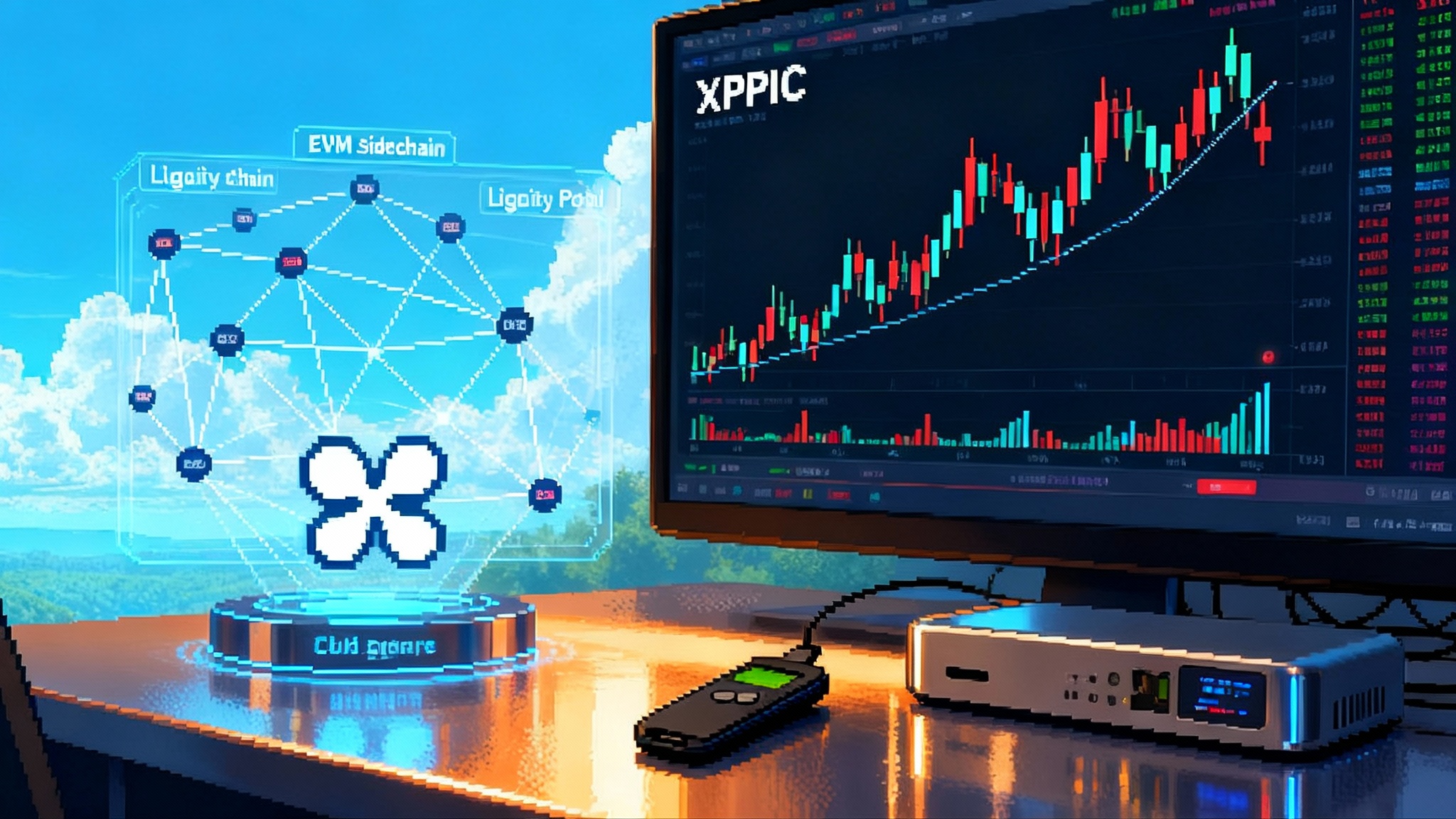XRP’s First U.S. Spot ETF Goes Live, Fueling XRPL’s EVM Run
Canary’s spot XRP ETF opened on November 13 with heavy demand, setting a 2025 day one record. Here is how regulated inflows could amplify activity on XRPL’s new EVM sidechain, AMMs, and payments, plus a practical playbook for builders and investors.

The news: regulated XRP exposure just arrived
On November 13, 2025, Canary Capital’s spot XRP exchange traded fund began trading in the United States. By the closing bell it logged a record first day among this year’s launches, with XRPC’s 58 million day one volume. The fund charges a 0.50 percent fee and holds spot XRP with institutional custodians Gemini Trust Company and BitGo Trust Company, allowing retail and advisors to access XRP through brokerage accounts rather than private keys.
Regulated wrappers can change behavior fast. We saw a similar dynamic when Solana’s first U.S. spot ETF broadened on chain market making and routing.
What changes with a spot ETF
Think of an exchange traded fund as a bridge between traditional allocators and a digital asset. Authorized participants create new shares by delivering cash or the underlying asset to the fund’s custodian. When demand rises, creations mint new shares and the sponsor buys more XRP, which moves across regulated accounts and chains. When demand falls, redemptions reverse the flow. The outcome is predictable even if the price is not: persistent inflows concentrate assets under custody at regulated firms, expand the lending base, and incentivize market makers to arbitrage spreads between the fund and spot markets.
Two immediate implications follow.
- Inventory gets warehoused in cold storage at custodians who can also facilitate settlement to on chain venues when clients request it. This tightens operational links between the fund complex and the ledger.
- Price discovery thickens. Market makers hedge exchange traded fund exposure in spot and derivatives, and they look for new places to earn spread. Wherever hedges are convenient and fees are low, liquidity follows.
This sits within a broader shift toward regulated crypto access, including policy progress summarized in America’s Stablecoin Law.
The spillover path to the ledger
ETF shares live inside brokerage accounts, not on chain. Yet the asset they represent still moves, and structured flows tend to create second order effects on chain. Here is the most likely sequence for XRP over the next few quarters.
-
Net inflows lift custodial balances at Gemini Trust Company and BitGo Trust Company. Those balances create operational muscle memory for compliant digital asset transfers.
-
Authorized participants, desks, and allocators seek lower friction hedges. Some will prefer on chain liquidity to avoid slippage in thin off chain order books during busy windows.
-
Builders respond by deepening venues that convert passive holding into active utility: automated market makers, payment rails that settle faster than fiat rails, and tokenized collateral flows.
-
As venues mature, treasurers and funds experiment with on chain workflows that respect policy controls. That experimentation compounds, especially where tooling already looks familiar to Ethereum developers.
XRPL’s EVM sidechain is live and points the way
In mid 2025 the XRP Ledger ecosystem shipped a major upgrade. Ripple announced that the EVM sidechain mainnet is live, bringing Ethereum Virtual Machine compatibility to XRPL while using XRP as gas and maintaining a direct bridge to the main network. The value of that design is practical. Developers can deploy the contracts they already know, then settle to XRPL’s proven payments layer. Investors can keep the asset they just bought through a regulated wrapper and still reach familiar decentralized finance primitives.
On the base ledger, XRPL has a built in decentralized exchange and automated market maker functionality integrated at the protocol level, so order books and pools can cooperate for best execution. On the EVM sidechain, builders can port battle tested Ethereum contracts, including patterns explored in Uniswap v4 hooks, from constant product exchanges to lending markets to market making vaults, with standard toolchains. The combination gives XRP a payments optimized core with a programmable edge.
Where the money could land first
-
Protocol liquidity. Exchange traded fund volume attracts market makers who want low cost hedges and reliable exits. Expect early growth in constant product pools on the EVM sidechain paired with native XRPL pools. Deep pools for XRP against major stablecoins and blue chip tokens will anchor price discovery and arbitrage routes.
-
Programmatic payments. Merchants and platforms that already touch XRP for settlement can add conditional logic with simple smart contracts, then settle final amounts to XRPL accounts. Think usage based payouts, split royalties, or recurring micro disbursements that reconcile in fiat at the edges.
-
Institutional custody hooks. As the fund’s custodians expand services for clients who hold ETF shares and also want direct XRP exposure, policy controlled wallets and segregated accounts become normal. That is the precondition for compliant on chain strategies.
-
Post trade plumbing. Clearing firms that service advisors and registered investment advisors may pilot automated fee sweeps or foreign exchange conversions using XRPL’s payment features, then roll up to fiat for books and records.
A practical playbook for builders
Below is a concrete checklist. It leans into the strengths of XRPL for payments and the EVM sidechain for programmable liquidity, and it assumes users will arrive through regulated on ramps rather than raw wallets.
1) Wallet user experience that feels like a brokerage app
- Use account abstraction patterns on the EVM sidechain to enable gas sponsorship with capped budgets. A user who bought the exchange traded fund should not hit a dead end because they lack gas on day one.
- Offer clear receipt level detail. Show the XRP amount, the fiat equivalent, the path used across XRPL or the EVM sidechain, and finality timing. This is the language compliance teams and advisors speak.
- Add role based controls. Distinguish between initiators, approvers, and auditors within a small team’s wallet. Make exportable logs a first class feature so that operations leaders can reconcile transactions without a separate tool.
2) Bridges without drama
- Prefer the canonical bridge between XRPL and its EVM sidechain for XRP, and avoid unofficial multi hop routes for core flows. More hops means more risk. Keep it boring for funds and treasurers.
- Build a bridge monitor. Track latency, queue depth, price gaps across pools, and recent validator events. Expose a one click “pause” for retail users and an automated circuit breaker for institutions when deviations exceed tolerances.
- Make “return to safety” a visible feature. If a user ends up with wrapped assets where they expected native XRP, give them a guided unwind back to layer one.
3) Market making that respects risk
- Start with a two pool structure. One pool on XRPL’s native automated market maker, one on the EVM sidechain. Seed with the same ratio, keep fees low at launch, and let the protocol’s auction or fee vote mechanisms adjust over time.
- Hedge exposure with simple rules. If the pool’s XRP inventory grows beyond a threshold, buy back the counter asset on the other venue or the centralized exchange you use for hedging. Publish the rules so liquidity providers understand behavior.
- Quote the exchange traded fund basis. Track the exchange traded fund premium or discount relative to the time weighted average price of spot XRP. When a discount widens, expect selling pressure in spot and be ready to deepen bids in pools at pre set intervals rather than chasing ticks.
4) Compliance integrations as product features
- Travel Rule by design. Integrate a Travel Rule provider so institutional users can pre clear destination addresses. Cache attestations to avoid repeat checks on frequent counterparties.
- On chain screening without friction. Run address risk scoring in the background and warn rather than block when possible. Offer a policy setting that forces dual approval above custom thresholds.
- Reporting that matches back office needs. Generate configurable reports with time windows, asset detail, origin, destination, and chain identifiers. Deliver in comma separated values and JavaScript Object Notation so finance and engineering can use them without reformatting.
5) Payments that justify using XRP
- Use XRPL’s payment channels for microtransactions. Set a channel per counterparty with a conservative settle window. When a budget threshold hits, close and settle on chain, then reopen. This keeps fees and chain load predictable.
- Add conditional payouts with the EVM sidechain. For example, escrow a publisher’s monthly revenue share with a simple contract, release to the XRPL address once the reporting period closes, and finalize with a single on chain payment.
- Keep foreign exchange simple. If you must convert at the edges, prefer stablecoin pairs with the deepest pools and track variance from trusted pricing benchmarks. Offer users a clear “slippage cap” input as part of the payment flow.
A practical playbook for investors
This is not investment advice, it is a framework for analysis and action.
- Map the liquidity surface. Track pool depth and spreads for XRP pairs on XRPL’s automated market maker and on the EVM sidechain. Shallow pools imply higher price impact and more lucrative fees for liquidity providers, but also greater impermanent loss. Adjust position sizes accordingly.
- Watch the exchange traded fund basis intraday. Persistent premiums often mean creation flow is lagging, which can pull spot price up. Persistent discounts can signal redemption pressure. Time entries and exits around those windows.
- Prefer protocol native yield to opaque wrappers. If you provide liquidity, understand the exact math of the pool, the fee distribution, and any auction mechanics for reduced fee slots. Avoid strategies you cannot model with a spreadsheet.
- Use policy controlled custody. If you graduate from exchange traded fund exposure to direct XRP, start with a custodian that supports whitelists, velocity limits, and insurance disclosures. Treat operational control as part of your return profile.
Risks to price and to plumbing
- Exchange traded fund demand is fickle. A hot open can follow with a cool month. Build with variable flows in mind, not a single launch day snapshot.
- Bridge risk is real. Even canonical bridges can have bugs. Keep critical flows on the simplest path possible and expose stop buttons to users.
- Liquidity fragmentation is the default. Multiple pools, two chain contexts, and centralized venues create many small lakes rather than one deep ocean. Mitigate with good routing and clear analytics.
- Regulatory drift happens. Listing standards can tighten or loosen. Design your product so that switching data providers, adding controls, or segmenting users by jurisdiction is a configuration change rather than a rebuild.
A 90 day build plan
Week 0 to 2
- Launch a clean wallet experience that supports both XRPL and the EVM sidechain with the same seed and clear gas indicators. Ship a simple tax report export. Add a toggle for compliance checks.
- Stand up two liquidity pools for XRP against the same stablecoin, one on each chain. Begin with conservative fee tiers and publish your rebalancing rules.
Week 3 to 6
- Integrate the canonical bridge with a dashboard that shows queue depth and warnings. Add a visible safety switch.
- Ship a payment channel pilot with a small merchant or partner. Pick a narrow use case like weekly payouts with a capped budget and show the savings against card rails.
Week 7 to 12
- Add role based approvals and policy limits for small teams and funds. Include a basic webhook so back offices can plug into alerts without custom code.
- Run a guarded liquidity mining program with clear caps and a posted risk guide. Pay rewards in the counter asset rather than inflationary tokens to attract pragmatic providers.
Week 13 to 14
- Publish transparency reports. Show bridge performance, pool metrics, failed compliance checks, and actions taken. Treat this as a product feature that earns user trust.
Why this could work now
The exchange traded fund does something social before it does anything mechanical. It gives institutions and advisors permission to care. Once they care, they need on chain places to express that interest with controls and clarity, not just speculation. XRPL’s DNA is payments and settlement, and its new EVM sidechain gives developers a familiar canvas to add logic. Combine those with the record opening day for regulated XRP exposure, and you have the ingredients for a programmable payments resurgence that is practical rather than nostalgic.
The bottom line
A strong exchange traded fund debut is a headline. The story that matters is what gets built because a new class of investors just found a safe front door. If builders focus on wallet clarity, boring bridges, disciplined market making, and compliance as a product, XRPL and its EVM sidechain can turn a week of tape into a cycle of utility. The opportunity is to let regulated inflows meet useful software, and to make that meeting feel as uneventful as a wire but as programmable as code.








